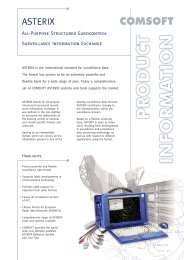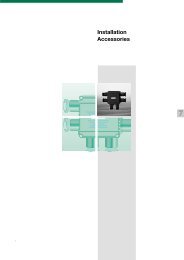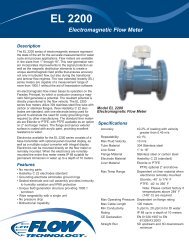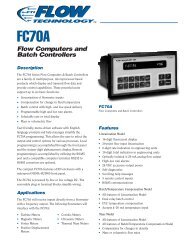Flow Technology FT Series Turbine Flowmeters for Liquid Applications
Flow Technology FT Series Turbine Flowmeters for Liquid Applications
Flow Technology FT Series Turbine Flowmeters for Liquid Applications
Create successful ePaper yourself
Turn your PDF publications into a flip-book with our unique Google optimized e-Paper software.
<strong>FT</strong> <strong>Series</strong><br />
Step 3: Bearing Selection<br />
Step 4: Calibration Selection<br />
• Bearings are available in two styles, Ball and Journal<br />
Sleeve.<br />
• Ball bearings are manufactured from 440C SS and is the<br />
typical choice <strong>for</strong> lubricating applications.<br />
• Journal Sleeve bearings are available in three different<br />
material selections. (Note: The Journal Ceramic bearing<br />
is the typical bearing of choice <strong>for</strong> non-lubricating appli<br />
cations.)<br />
• See page 5 <strong>for</strong> bearing selection options.<br />
Ball bearings (model # code “A”)<br />
• Bearing option to measure lubricating fluids.<br />
• Low frictional drag provides the widest possible flow<br />
range.<br />
• Ball bearing set can be replaced in the field.<br />
• 10 to 50 micron filtration required, dependent on meter<br />
size.<br />
• Operating temperature range of -266˚ to 149˚ C.<br />
• 440C stainless steel materials of construction.<br />
• Provides exceptional life and rugged construction in<br />
clean lubricating applications.<br />
Journal Carbide bearings (model # code “D”)<br />
• Bearing option to measure low or non-lubricating fluids.<br />
• Hard bearing material provides long life and rugged construction.<br />
• Less turn down capability than the ball bearing. (valid <strong>for</strong><br />
all journal bearing options)<br />
• Field replacement of bearing not recommended. (valid<br />
<strong>for</strong> all journal bearing options)<br />
• 75 to 100 micron filtration required. (valid <strong>for</strong> all journal<br />
bearing options)<br />
• Operating temperature range of -73˚ to 648˚ C.<br />
• Tungsten Carbide materials of construction.<br />
• Hard bearing material provides long life and rugged con<br />
struction.<br />
Journal Graphite bearings (model # code “E”)<br />
• Bearing option <strong>for</strong> corrosive applications.<br />
• Operating temperature range of -73˚ to 288˚ C.<br />
• Bearing option to measure low or non-lubricating fluids.<br />
• Materials of construction are epoxy impregnated Carbon<br />
Graphite bearing with 316 SS shaft.<br />
• Lubricating property of the graphite allows this bearing to<br />
run smoother than the other two journal options, however<br />
life of the bearing will be slightly reduced.<br />
• Not recommended <strong>for</strong> use above <strong>FT</strong>-32 meter size.<br />
• <strong>Flow</strong> <strong>Technology</strong> has one of the world’s largest liquid<br />
and gas primary calibration facilities.<br />
• The ability to accurately calibrate a flow meter with trace<br />
ability to international standards is one of the fundamental<br />
requirements in any flow metering application.<br />
• <strong>Flow</strong> <strong>Technology</strong> offers a range of water, solvent, oil, and<br />
oil blend calibrations.<br />
• A 10 data point calibration is offered as standard, 20 and<br />
30 point calibrations are offered as options. A higher<br />
number of data points will define the calibration curve in<br />
more detail. If linearizing electronics will be used a mini<br />
mum of a 20 point calibration is recommended.<br />
• Viscosity does shift the flow meter calibration curve and<br />
should be compensated <strong>for</strong>.<br />
Application will be at relatively constant temperature<br />
and viscosity<br />
• For optimum per<strong>for</strong>mance your flow meter should be calibrated<br />
close to its operating viscosity. Water at 1 cst and<br />
solvent at 1.2 cst viscosity is standard, a specific calibration<br />
to simulate the operating viscosity can be specified<br />
as an option.<br />
Application will cover a range of operating temperature<br />
and viscosity<br />
• If the fluid viscosity or density is changing due to temperature<br />
variation, a Universal Viscosity Calibration (UVC)<br />
should be used to per<strong>for</strong>m real time temperature correction.<br />
• The viscosity range <strong>for</strong> the calibration is determined by<br />
the minimum fluid viscosity at the maximum operating<br />
temperature and the maximum fluid viscosity at the minimum<br />
operating temperature.<br />
• See page 5 <strong>for</strong> calibration options.<br />
Journal Ceramic bearings (model # code “G”)<br />
• Typical bearing option to measure low or non-lubricating<br />
fluids.<br />
• Operating temperature range of -73˚ to 427˚ C.<br />
• Typical bearing option <strong>for</strong> more corrosive applications.<br />
• AL2O3 (99.5%) Ceramic materials of construction.<br />
• Ceramic material is impervious to most fluids, resists film<br />
build up on bearing surface, long life, not as robust as<br />
tungsten carbide material.<br />
• Not recommended <strong>for</strong> use in water above 82˚ C.<br />
3









